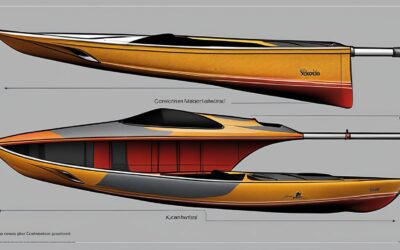When choosing a kayak, one of the most critical decisions you have to make is whether to opt for an inflatable or hard-shell kayak. While there is no one-size-fits-all answer to this question, it’s essential to consider factors such as durability and performance to ensure you pick a kayak that meets your needs and preferences.
Inflatable and hard kayaks have advantages and disadvantages, and it’s up to you to determine which works best for you. In this article, we’ll look closer at the durability and performance of inflatable and hard kayaks and their impact on your on-water experience.
Key Takeaways:
- Choosing between an inflatable and a hard-shell kayak requires careful consideration of factors such as durability and performance.
- Both types of kayaks have advantages and disadvantages that may affect your on-water experience.
- Durability is crucial, as it determines how well the kayak can withstand wear and tear, impacts, and environmental factors.
- Performance factors such as maneuverability, stability, tracking, and speed can impact how the kayak handles the water.
- The final decision largely depends on your specific needs and preferences.
Pros and Cons of Inflatable Kayaks
If you’re in the market for a kayak, you may be debating between an inflatable kayak and a hard one. While both options have advantages and disadvantages, inflatable kayaks are becoming increasingly popular for their unique benefits.
The Benefits of Inflatable Kayaks
One of the biggest advantages of inflatable kayaks is their portability. They are lightweight and easy to pack up and transport, which makes them ideal for adventure seekers who want to explore various bodies of water.
Inflatable kayaks are also easy to store, as they can be deflated and stored in a compact space. This feature makes it easier for kayakers who live in small apartments or don’t have access to a garage or outdoor storage space.
Another benefit of inflatable kayaks is their affordability. Compared to hard kayaks, inflatable ones are generally less expensive, making them a great option for beginners or those on a budget.
The Drawbacks of Inflatable Kayaks
One of the biggest concerns with inflatable kayaks is their durability. While they are made of tough, puncture-resistant materials, they are still vulnerable to punctures and tears from sharp objects.
Additionally, inflatable kayaks have a lower top speed and are less efficient than hard kayaks. This factor can disadvantage experienced kayakers who want to move quickly through the water.
Inflatable Kayak Reviews
| Pros | Cons |
|---|---|
| Portability and easy storage | Lower top speed |
| Affordable compared to hard kayaks | Potential for punctures and tears |
| Lightweight and easy to transport | Not as efficient as hard kayaks |
Overall, inflatable kayaks are a great option for kayakers who value portability and affordability. However, those who prioritize speed and efficiency may want to consider a hard-shell kayak instead.
Pros and Cons of Hard-Shell Kayak
If you’re considering a hard kayak, it’s important to understand their advantages and disadvantages. In this section, we will explore the benefits and potential drawbacks of hard kayaks, to help you make an informed decision.
Advantages of Hard Kayaks
Hard kayaks offer several advantages, including:
- Performance: Hard kayaks are faster and more responsive than inflatable kayaks, making them ideal for racing or exploring open waters.
- Durability: Hard kayaks are more resistant to punctures and wear and tear than inflatable kayaks, making them more suitable for rougher waters.
- Stability: Hard kayaks tend to be more stable than inflatable kayaks, especially in choppy or windy conditions.
- Customization: Hard kayaks can be customized to fit your specific needs and preferences, whether you want a kayak for fishing, touring, or racing.
Overall, hard kayaks are a great choice if you’re looking for a high-performance kayak that can handle rougher waters and be customized to fit your needs.
Potential Drawbacks of Hard-Shell Kayak
While hard kayaks have several advantages, they also have potential drawbacks, such as:
- Transportation: Hard kayaks require a roof rack or trailer, making them less portable than inflatable kayaks.
- Storage: Hard kayaks take up more storage space than inflatable kayaks, so you need enough space to store your kayak when it’s not in use.
- Comfort: Hard kayaks tend to have less comfortable seating than inflatable kayaks, so you may need to invest in additional padding or a seat cushion.
- Cost: Hard kayaks can be more expensive than inflatable kayaks, especially if you want a high-performance or customized kayak.
Despite these potential drawbacks, hard kayaks remain a popular choice among serious kayakers who want a kayak that can handle anything nature throws at them.
Durability Comparison: Inflatable vs Hard-Shell Kayak
When looking for a kayak, durability is a crucial factor to consider. Both inflatable and hard kayaks have their unique qualities, but their durability is a significant differentiating aspect.
An inflatable kayak is made of lightweight materials that can be susceptible to punctures, tears, and general wear and tear. However, the materials used to construct inflatable kayaks have improved over the years. The newer models are now made of heavy-duty PVC, reinforced with nylon, making them more durable and resistant to punctures.
On the other hand, hard kayaks are typically constructed from plastic or composite materials. They are strong and can withstand the elements better than inflatable kayaks. However, hard kayaks are known to get scratched, cracked, and damaged, especially when used in rocky rivers or shores.
| Inflatable Kayak | Hard-Shell Kayak | |
|---|---|---|
| Pros | More resistant to punctures and general wear and tear | Can withstand the elements better |
| Cons | Can be more susceptible to punctures | Can get scratched, cracked, and damaged |
When it comes to maintenance, inflatable kayaks require a bit of upkeep to maintain their durability. The kayaks need to be dried, deflated, and stored appropriately after each use. Hard kayaks, on the other hand, need less maintenance since they do not need to be inflated or dried after each use. However, they should be cleaned, dried, and stored in a cool, dry place to avoid damage from the sun and other external elements.
In conclusion, both inflatable and hard kayaks have their unique qualities, and durability should be a crucial consideration when making a purchase. While both types of kayaks are prone to wear and tear, inflatable kayaks are more susceptible to punctures, while hard kayaks can get scratched, cracked, and damaged.
Performance and On-Water Experience: Inflatable vs Hard Kayak
When it comes to kayaking, performance and on-water experience are key considerations to keep in mind. Inflatable and hard kayaks differ in their abilities, and each has advantages and disadvantages when it comes to performance and on-water experience.
Maneuverability
Inflatable kayaks tend to be more maneuverable on the water due to their flexibility. Their ability to bend and flex allows for easy turning and maneuvering around obstacles. Hard kayaks, on the other hand, tend to be less flexible and may require more effort to navigate in tight spaces.
Stability
Inflatable kayaks tend to offer less stability on the water compared to hard kayaks. This is due to their lightweight and flexible design. Hard kayaks, on the other hand, offer more stability due to their rigid structure and ability to handle waves and currents with greater ease.
Tracking
Tracking refers to the ability of a kayak to maintain its course on the water. Hard kayaks have better tracking abilities than inflatable kayaks due to their streamlined design and ability to cut through the water with greater ease. Inflatable kayaks may struggle to maintain a straight course in choppy waters or when faced with currents.
Speed
When it comes to speed, hard kayaks have the advantage. Their streamlined design and rigid structure allow for faster movement through the water. Inflatable kayaks, while still able to move quickly, may not be able to match the speed of hard kayaks due to their flexible design and lighter weight.
Overall On-Water Experience
The on-water experience is impacted by a combination of factors, including maneuverability, stability, tracking, and speed. Inflatable kayaks offer a more comfortable and relaxing experience due to their cushioned seats and flexibility. Hard kayaks, on the other hand, provide a more thrilling and adventurous experience due to their speed and ability to handle rough waters. Your personal preference and intended use for the kayak will determine which on-water experience is best for you.
Conclusion
Now that you’ve explored the pros and cons of inflatable and hard kayaks, it’s time to make a decision based on your needs and preferences.
When it comes to a comparison between inflatable kayak vs hard kayak, you should consider factors such as durability, performance, portability, and storage.
If you prioritize ease of transportation and storage, an inflatable kayak may be the right choice for you. On the other hand, if you want a faster and more high-performance kayak, a hard kayak may be the better option.
Inflatable Kayak Buying Guide
When buying an inflatable kayak, there are a few things to keep in mind:
- Look for kayaks made with heavy-duty materials, such as PVC or nylon, for increased durability
- Check the weight capacity to ensure it can hold your weight and any gear you plan to bring along
- Consider the included accessories, such as a pump or paddles, to determine the overall value of the kayak
- Read reviews from other customers to get an idea of the kayak’s real-world performance and any potential issues to look out for
Hard Kayak Buying Tips
When buying a hard kayak, here are a few tips to keep in mind:
- Consider the type of water you’ll be kayaking on, as certain kayaks are designed for specific types of water
- Look for kayaks made with durable materials, such as fiberglass or plastic, for increased longevity and performance
- Consider the size and weight of the kayak, as larger kayaks may require more storage space and be more difficult to transport
- Try out the kayak before purchasing, if possible, to get a feel for its maneuverability and comfort
By considering these factors and following these tips, you can make an informed decision and choose the kayak that’s right for you.
FAQ
What is the difference between an inflatable kayak and a hard kayak?
An inflatable kayak is made from flexible and durable materials that can be inflated and deflated for easy storage and transportation. On the other hand, a hard kayak is made from rigid materials like plastic or fiberglass and maintains its shape without the need for inflation.
What are the benefits of using an inflatable kayak?
Inflatable kayaks offer benefits such as portability, as they can be easily deflated and stored in a compact space. They are also lightweight, making them easier to transport. Additionally, inflatable kayaks tend to be more affordable compared to hard kayaks.
What are the drawbacks of using an inflatable kayak?
One potential drawback of inflatable kayaks is their vulnerability to punctures, which can impact their durability and performance. They also tend to be slower in the water compared to hard kayaks due to their design and materials.
What are the advantages of using a hard kayak?
Hard kayaks offer advantages such as better speed and performance in the water. They are also more durable and resistant to punctures compared to inflatable kayaks. Additionally, hard kayaks tend to have better tracking and maneuverability.
What are the disadvantages of using a hard kayak?
One potential drawback of hard kayaks is their need for storage space, as they cannot be deflated like inflatable kayaks. They are also heavier and can be more challenging to transport. Additionally, hard kayaks tend to be more expensive compared to inflatable ones.
How do inflatable and hard kayaks compare in terms of durability?
Inflatable kayaks are made from durable materials like PVC or Hypalon, which are designed to withstand impacts and resist punctures. However, they are more susceptible to wear and tear over time. Hard kayaks, on the other hand, are made from rigid materials like plastic or fiberglass, making them more resistant to damage.
How do inflatable and hard kayaks differ in terms of on-water performance?
Inflatable kayaks tend to offer better stability due to their wider designs, making them a good choice for beginners or recreational paddling. They also perform well in calm waters. Hard kayaks, on the other hand, offer better speed, tracking, and maneuverability, making them suitable for more experienced kayakers and rougher water conditions.






